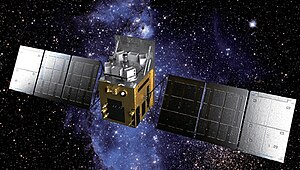Astronomy:Hard X-ray Modulation Telescope
 Rendering of HXMT | |
| Mission type | Astronomy |
|---|---|
| Operator | CAS / IHEP |
| SATCAT no. | 42758[1] |
| Website | http://www.hxmt.org/ |
| Mission duration | Elapsed: 7 years, 5 months, 12 days[2] |
| Spacecraft properties | |
| Launch mass | 2,800 kg (6,200 lb)[2] |
| Dimensions | 2.0 × 2.0 × 2.8 m (6.6 × 6.6 × 9.2 ft)[2] |
| Start of mission | |
| Launch date | June 14, 2017, 03:00:00 UTC [2] |
| Rocket | Long March 4B[2] |
| Launch site | 603 Launch Pad of the LC43 Launch Complex, Jiuquan Satellite Launch Center[2] |
| Orbital parameters | |
| Reference system | Geocentric[1] |
| Regime | Low Earth[1] |
| Semi-major axis | 6,920 km (4,300 mi)[1] |
| Eccentricity | 0.0006597[1] |
| Perigee altitude | 545 km (339 mi)[1] |
| Apogee altitude | 554.1 km (344.3 mi)[1] |
| Inclination | 43.0°[1] |
| Period | 95.5 minutes[1] |
| Mean motion | 15.079 rev/day[1] |
| Epoch | 2017-06-22 11:32:39 UTC[1] |
Hard X-ray Modulation Telescope (HXMT) also known as Insight (Chinese: 慧眼)[3] is a Chinese X-ray space observatory, launched on June 15, 2017[2] to observe black holes, neutron stars, active galactic nuclei and other phenomena based on their X-ray and gamma-ray emissions.[4] It is based on the JianBing 3 imagery reconnaissance satellite series platform.
The project, a joint collaboration of the Ministry of Science and Technology of China, the Chinese Academy of Sciences, and Tsinghua University, has been under development since 2000.
Payload
The main scientific instrument is an array of 18 NaI(Tl)/CsI(na) slat-collimated "phoswich" scintillation detectors, collimated to 5.7°×1° overlapping fields of view.[5] The main NaI detectors have an area of 286 cm2 each, and cover the 20–200 keV energy range. Data analysis is planned to be by a direct algebraic method, "direct demodulation",[6] which has shown promise in de-convolving the raw data into images while preserving excellent angular and energy resolution.
The satellite has three payloads, the high energy X-ray Telescope (20–250 keV), the medium energy X-ray telescope (5–30 keV), and the low energy X-ray telescope (1–15 keV)[2]
See also
References
- ↑ 1.00 1.01 1.02 1.03 1.04 1.05 1.06 1.07 1.08 1.09 1.10 HXMT (HUIYAN)
- ↑ 2.0 2.1 2.2 2.3 2.4 2.5 2.6 2.7 Rui C. Barbosa (14 June 2017). "China launches X-ray telescope via Long March 4B". NASASpaceFlight.com. https://www.nasaspaceflight.com/2017/06/china-x-ray-telescope-long-march-4b/.
- ↑ "China launches space telescope to search for black holes, pulsars - Xinhua | English.news.cn". news.xinhuanet.com. http://news.xinhuanet.com/english/2017-06/15/c_136367916.htm.
- ↑ Andrew Jones. "Tiangong-2 to launch next week in step towards Chinese space station". gbtimes.com. Sep 8, 2016. https://gbtimes.com/tiangong-2-launch-next-week-step-towards-chinese-space-station.
- ↑ HXMT.cn, Configuration (Hard X-ray telescope design) c.2004
- ↑ HXMT.cn, The direct demodulation method (Imaging by direct deconvolution) c.2004
 |


